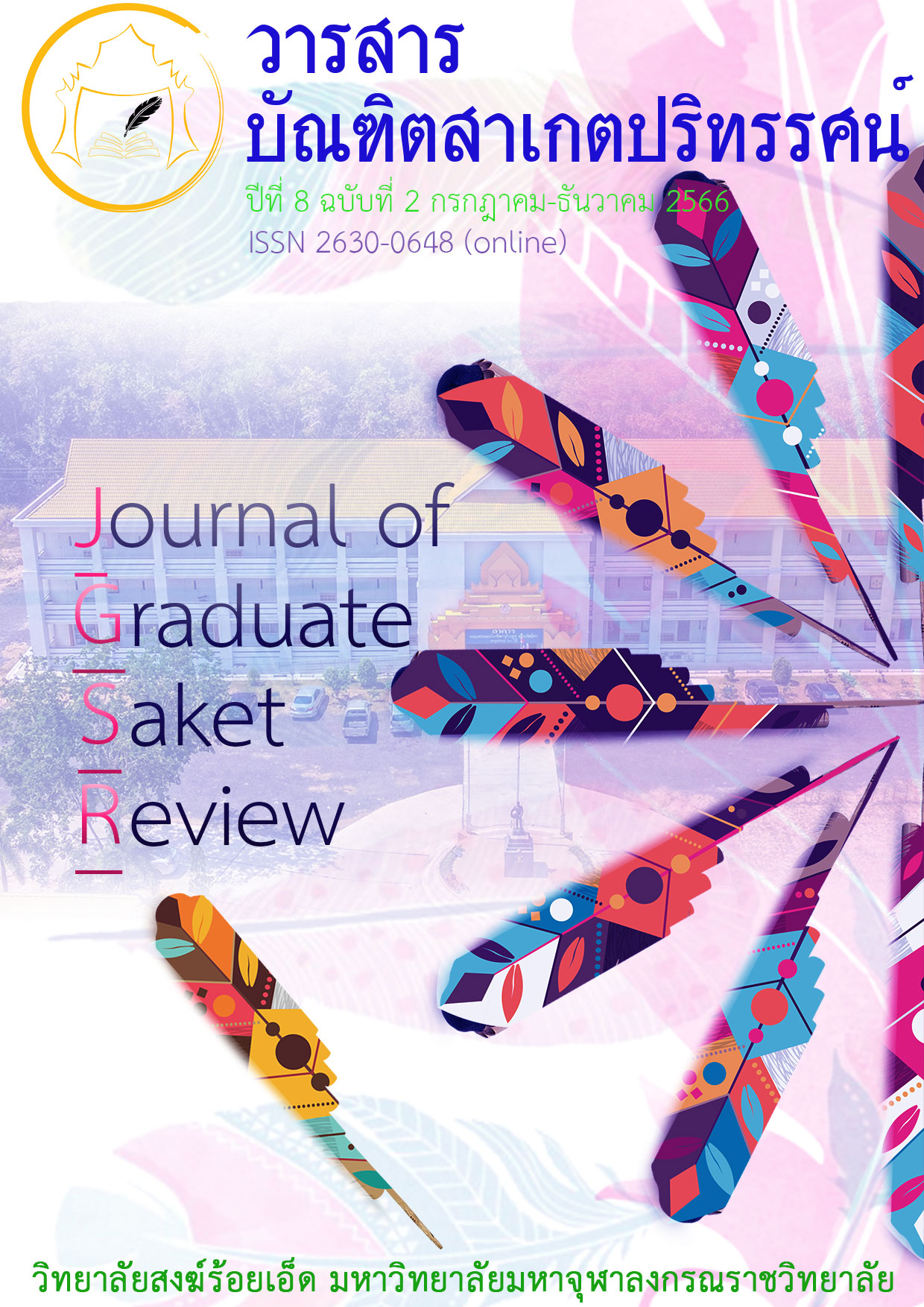The development of learning by using 5 practices and mathematical tasks in statistics to promote statistical reasoning skills for grade 7 students
Main Article Content
Abstract
This research aimed to study the appropriate learning implementation using 5 practices and mathematical tasks and to study the effects of learning implementation using 5 practices and mathematical tasks in statistics on statistical reasoning skills for grade 7 students. The target group is 40 grade 7 students. This research was classroom action research which was 4 cycles. The research tools were 4 lesson plans, reflection form, activity sheets, and
statistical reasoning skills test. Data were analyzed using content analysis and checking for data credibility by triangulation method. The results showed that the learning implementation using 5 practices and mathematical tasks, were 5 steps: Anticipating, Launching, Monitoring, Selecting and Sequencing, and Connecting. There were issues that should be emphasized: 1) Teacher should design mathematical assignments and activity sheets according with teaching content and concept. 2) Teacher should use probing questions for students’ understanding of the problem and encouraging students to apply basic knowledge in reasoning support. 3) Students with incorrect or inaccurate answers/concepts should be ranked first and 4) The learning should be divided into small groups for students to express their opinions before connecting to the concept conclusion for the whole class. In addition, most students have statistical reasoning skills in a very good level. For considering the components of statistical reasoning skills, they were developed in descending order which are representation data, analysis and interpreting, organizing and describing data respectively. Therefore, the appropriate learning implementation using 5 practices and mathematical tasks can develop statistical reasoning skills of students.
Article Details

This work is licensed under a Creative Commons Attribution-NonCommercial-NoDerivatives 4.0 International License.
เนื้อหาและข้อมูลในบทความที่ลงตีพิมพ์ในวารสารบัณฑิตสาเกตปริทรรศน์ ถือเป็นข้อคิดเห็นและความรับผิดชอบของผู้เขียนบทความโดยตรงซึ่งกองบรรณาธิการวารสาร ไม่จำเป็นต้องเห็นด้วย หรือร่วมรับผิดชอบใด ๆบทความ ข้อมูล เนื้อหา รูปภาพ ฯลฯ ที่ได้รับการตีพิมพ์ในวารสารบัณฑิตสาเกตปริทรรศน์ ถือเป็นลิขสิทธิ์ของวารสารบัณฑิตสาเกตปริทรรศน์ หากบุคคลหรือหน่วยงานใดต้องการนำทั้งหมดหรือส่วนหนึ่งส่วนใดไปเผยแพร่ต่อหรือเพื่อกระทำการใด ๆ จะต้องได้รับอนุญาตเป็นลายลักอักษรจากวารสารบัณฑิตสาเกตปริทรรศน์ ก่อนเท่านั้น
References
กระทรวงศึกษาธิการ. (2560). ตัวชี้วัดและสาระการเรียนรู้แกนกลาง สาระการเรียนรู้คณิตศาสตร์ (ฉบับปรับปรุง พ.ศ. 2560) ตามหลักสูตรแกนกลางการศึกษาชั้นพื้นฐาน พุทธศักราช 2551. กรุงเทพมหานคร: ชุมชนสหกรณ์การเกษตรแห่งประเทศไทย.
ชมนาด เชื้อสุวรรณทวี. (2561). การเรียนการสอนคณิตศาสตร์. กรุงเทพมหานคร: จุฬาลงกรณ์มหาวิทยาลัย.
ณัฐกานต์ อารีรัตนเวช, และวนินทร พูนไพบูลย์พิพัฒน์. (2564). การจัดกิจกรรมการเรียนรู้โดยใช้แนวปฏิบัติการสอน 5 ขั้น เพื่อส่งเสริมการนำเสนอตัวแทนความคิดทางคณิตศาสตร์ เรื่อง ฟังก์ชัน ของนักเรียนชั้นมัธยมศึกษาปีที่ 4. วารสารครุศาสตร์อุตสาหกรรม. 20(2), 45-56.
นิราวรรณ หมู่ธรรมไชย. (2560). การส่งเสริมความสามารถในการให้เหตุผลทางคณิตศาสตร์ เรื่อง ความสัมพันธ์และฟังก์ชันของนักเรียนชั้นมัธยมศึกษาปี ที่ 4 โดยใช้งานทางคณิตศาสตร์. วิทยานิพนธ์ปริญญาศึกษาศาสตรมหาบัณฑิต. เชียงใหม่: มหาวิทยาลัยเชียงใหม่.
รหัท ติ๊บแปง, จักรกฤษ กลิ่นเอี่ยม, และวนินทร สุภาพ. (2562). การพัฒนาความสามารถในการเชื่อมโยงทางคณิตศาสตร์ด้วยการจัดกิจกรรมการเรียนรู้แบบบริบทเป็นฐาน เรื่อง อัตราส่วนและร้อยละ สำหรับนักเรียนชนเผ่าชั้นมัธยมศึกษาปีที่ 2. รายงานสืบเนื่องจากการประชุมวิชาการ. เสนอผลงานวิจัยระดับบัณฑิตศึกษาแห่งชาติครั้งที่ 48 ร่วมกับการประชุมวิชาการบัณฑิตศึกษาระดับชาติและนานาชาติ ครั้งที่ 9, 13-14 มิถุนายน 2562 (หน้า 342-350). นครปฐม: มหาวิทยาลัยศิลปากร.
วรัญญา ม่วงวัดท่า, วนินทร สุภาพ, และสิรินภา กิจเกื้อกูล. (2562). การพัฒนาทักษะการให้เหตุผลเชิงสถิติ โดยการจัดการเรียนรู้ด้วยรูปแบบบันได 5 ขั้น (QSCCS) เรื่อง สถิติ สำหรับนักเรียนชั้นมัธยมศึกษาปีที่ 1. รายงานสืบเนื่องจากการประชุมวิชาการระดับชาต.ิ การศึกษาเพื่อพัฒนาการเรียนรู้ ครั้งที่ 3, 31 พฤษภาคม 2562, (หน้า 1433-1442). กรุงเทมหานคร: มหาวิทยาลัยราชภัฏสวนสุนันทา.
เวชฤทธิ์ อังกนะภัทรชจร. (2556). การพัฒนาความสามารถในการให้เหตุผลเชิงสถิติและการเชื่อมโยงคณิตศาสตร์ไปสู่ชีวิตจริง โดยใช้กิจกรรมการเรียนรู้แบบการสอนแนะให้รู้คิด (CGI) ร่วมกับการใช้คำถามระดับสูง สำหรับนักเรียนชั้นมัธยมศึกษาปีที่ 6. วารสารศึกษาศาสตร์ มหาวิทยาลัยบูรพา. 24(2), 15-33.
ทรรศมน วินัยโกศล, และไพโรจน์ น่วมนุ่ม. (2562). ผลการจัดกิจกรรมการเรียนรู้คณิตศาสตร์ตามโมเดลของสไตล์ที่มีต่อความรู้และความสามารถในการให้เหตุผลทางคณิตศาสตร์ของนักเรียนมัธยมศึกษาปีที่ 3. วารสารอิเล็กทรอนิกส์ทางการศึกษา. 14(1), 1-16.
สถาบันทดสอบทางการศึกษาแห่งชาติ. (2564). สรุปผลการทดสอบทางการศึกษาระดับชาติขั้นพื้นฐาน (O-NET): ชั้นมัธยมศึกษาปีที่ 3 ปีการศึกษา 2564. สืบค้น 27 พฤษภาคม 2565, จาก NIETS: https://www.niets.or.th/uploads/editor/files/O-NET/rapid%20report%20M32564.pdf
สถาบันส่งเสริมการสอนวิทยาศาสตร์และเทคโนโลยี. (2555). ทักษะกระบวนการทางคณิตศาสตร์. กรุงเทพมหานคร: 3-คิว มีเดีย.
อัมพร ม้าคนอง. (2554). ทักษะและกระบวนการทางคณิตศาสตร์: การพัฒนาเพื่อพัฒนาการ. กรุงเทพมหานคร: โรงพิมพ์แห่งจุฬาลงกรณ์มหาวิทยาลัย.
Hennings, M., & Stein, M. K. (1997). Mathematical tasks and student cognition: Classroom – based. Journal For Research In Mathematics Education. 28(5), 524-549.
Angganapattarakajorn, W. (2013). Development of Statistical Reasoning and Connecting Mathematics to Real Life Using Instructional Activities Based on Cognitively Guided Instruction and Higher Order Questions for Grade 6 Students (in Thai). Journal of Education Burapha University. 24(2), 15-33.
Areerattanawet, N. & Poonpaiboonpipat, W. (2021). Learning activities based on 5 practices to enhance mathematical representation on function for grade 10 students (in Thai). Journal of Industrial Education. 20(2), 45–56.
Cheausuwantavee, C. (2018). Teaching Mathematics (in Thai). Bangkok: Chulalongkorn University Press.
Makanong, A. (2011). Mathematical skills and processes: Development for development (in Thai). Bangkok: Chulalongkorn University.
Ministry of Education. (2017). Indicators and learning subjects in the core of mathematics learning subject groups. (Revised Edition B.E. 2560) According to the Core Curriculum of Basic Education B.E. 2551 (2008) (in Thai). Bangkok: Agricultural cooperative printing demonstrations of Thai co., Ltd.
Moothummachai, N. (2560). Promoting Mathematical Reasoning Abilities in Relations and Functions of Grade 10 Students by Using Mathematical Tasks (in Thai). Master’s Thesis.Chiang Mai: Chiang Mai University.
Muengwadtta, W., Supap W., & Kijkuakul, S. (2019). The Development of Statistical Reasoning Skills Using 5 Steps Learning Process (QSCCS) in Statistics for Grade 7 Students (in Thai). Proceedings of 3th. The National Conference on Education for Learning
Development. (pp. 1433-1442). May 31, 2019. Bangkok: Suan Sunandha Rajabhat University
National Institute of Educational Testing Service (Public Organization). (2021). Summary of the national basic educational testing (O-Net), grade 9, Academic year 2017 (in Thai). Retrieved 25 May 2022, From NIETS: https://www.niets. or.th/ uploads/ editor/files/O-NET/rapid%20report%20M3-2564.pdf
The Institute for the Promotion of Teaching Science and Technology. (2012). Mathematical Process Skills (in Thai). Bangkok: 3-Q Media.
Tibpaeng, R., Klineam, C., & Supap, W. (2019). The Development of Mathematical Connection Ability through Context-Based Learning in Ratio and Percentage for Tribesman Students in Grade 8 (in Thai). Proceedings of 48th National Graduate Studies Research Conference in conjunction with the 9th National and International Graduate Studies Conference. (pp. 342-350).June 13-14, 2019. Nakhon Pathom: Silpakorn University.
Winaikosol, T., & Noumnom, P. (2019). Effects of organizing mathematics learning activities using stein’s model on mathematical knowledge and reasoning ability of ninth grade students (in Thai). An Online Journal of Education. 14(1), 1-16.
Hennings, M., & Stein, M. K. (1997). Mathematical tasks and student cognition: Classroom – based. Journal For Research In Mathematics Education. 28(5), 524-549.


